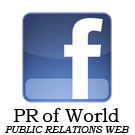Even though the millennia wonders of the IT era were intriguing for both Swedish PR professionals and students alike – especially as the wonderous bubble grew bigger and bigger – there weren’t really any discussions on how IT were going to impact the profession. In the local universities, some courses on how to ”write for the web” were taught, but that was just about it.
Those of us who managed to escape the traditional ”Kotlerisms” found something of a safe haven in the teachings of James E. Grunig, who rose to fame and acclaim mostly because he and his collaborators via the Excellence study managed to establish that organizations actually benefits financially by taking part in two-way symmetrical public relations campaigns.
In short, dialogue and win-win approaches ought the be both the old and the new black in PR.
Still, no-one really connected the dots. Or maybe someone did, but didn’t manaage to turn it into a business model for PR. In either way, the market were probably ready for some corporate dialogue, but the organizations weren’t. Not yet, anyhow.
And when the great bubble finally imploded, the consequences weren’t exactly the boost the scarce digital PR enthusiasts were hoping for at the time. And at the universities, we often times explained what we saw using the principles of the so cold media logic as some sort of dominant explanation model.
Media logic offered an explanation for how the (news) media worked – and it proved to be very useful when applied. The news media always emphasized objectivity and newsworthiness as key indicators of how our societal discourse were created. Media logic explained that this was true, but that other factors also was to be taking into account.
Altheide and Snow [Robert L. & David? What was the name of their theory? Titles? I will update this!] pointed out that news outlets never existed in a vacuum and that there are other factors on different levels deciding what will turn into news stories and what wouldn’t.
On another level, Swedish scientists like jesper Strömbäck made considerable contributions, adding to a list of media logic effects, such as polarization, simplification, stereotypification etc. Everything was derived from what journalists, editors and media executives saw worked the best for their specific editorial product.
By a thorough understanding for the principles of media logic, both PR professionals and PR students seemed to have all the tools to understand and to help organisations to communicate better. Ant to sometimes - ”write for the web”.
As it were, Swedish PR could easily serve as a prime example of a profession being just another media and channel centric marketing tool. The idea of dialogue and win-win transcended only in random sales pitches and in the minds of idealistic (excentric?) PR students.
For me, who after my studies entered the PR profession into a stone cold recession, I found IRL PR to be quite puzzling. And as the times quickly got better, the more it puzzled me.
It got even stranger as my thesis Strategic News (SWE/PDF) in 2003 got awarded twice for what it was – a qualitative outlook on how senior PR professionals could utilize the principles of media logic in order to get closer to their organisations strategic objectives. The thesis made some strong points for a news media centric society for sure, but some pieces of the puzzles were definitely still missing.
As for the teachings of James E. Grunig and his (somewhat complicated) two-way symmetrical approach, it just seemed much easier to adapt all PR campaigns to a more retorical top-down approach. That was the way Edward Bernays had first described his thoughts of the PR practices, so why not? It seemed to be working fine at a time when everyone just wanted as much traditional publicity as they possible could have.
One of the most puzzling elements of modern PR were definitely the comfortable demographic approach to market segmentation. Instead of categorising influentials on psychosocial grounds in a way that would have made even the great social psychologist [forgot his name, brb] proud, we never did; instead the media and channel centric professionals just segmented and analysed the world in the same manner the news outlets and advertisers did, and then mainly on basis of where people live and cynically enough – on the contents of their wallets.
This extremely cynical, top-down media and channel centric view on how to tailor PR campaigns probably added to the often times shameful reputation the profession have been so closely associated with, actually ever since PR emerged as a bonafide profession back in the days of the forementioned Edward Bernays.
So, as the social web started to emerge in what was left of the former so enthusiastic IT community, many PR professionals instinctively understood that this new exciting area was somehow important to their future business model - without being exactly sure why. But the profession had since long forgot about two-way communication and the importance of understanding publics on basis of how and why they communicate.
Being somewhat of a long and awkward title, when Brian Solis published Putting the public back into public relations, it almost magically encapsulated what at least ought to be the ultimate PR zeitgeist - and it got recognized by many Swedish PR professionals, mostly for its contibution to social media understanding, but also for its outlook on what public realtions ougth to be!
Suddenly, the dots were connected all the way from the classical two-way symmetrical model to psychosocial segmentation into publics.
With all of this in mind, the PR profession should now – at least – know who to listen and engage in conversation with. If that could the starting point for most organizations, it would maybe save us from a world of Neil Postman-dystopia where top-down infotainment slowly are choking us all to death.
Still, Brian Solis is just one PR professional and his influence only reaches so far. And, as we all PR professionals ought to know by know; change may take place over night, but the process of organisational adaption is often times a painstakingly slow one.
But there is a real problem to be dealt with right now, and that is the principles of media logic. As I see it, these principles seem to mislead us in practically every context the social web has to offer us! And this is sort of embarressing since we, the talented PR professionals, should be merchants of trust and not just retorical mercenaries.
Maybe we should refer to these principles as the news media logic, because there is a real difference. What makes the front page of a news paper isn’t necessarily the same thing as what the publics choose to learn from their interactions on the social web. Ever tried to pitch a blogger? There you go; bloggers aren’t necessarily interested in news, they are merely interested in… well, their interest.
Since traditional media logic is derived from a news process point of view, the principles suddenly become useless in our efforts to harness the power of the social web.
News media logic can actually strain social relations, if you think about it! If you stretch or spin your message according to every dark little secret in your black Moleskine playbook, chances are your friends will ask you what the hell you are up to? Q: Why don’t you speak with us like the intelligent human beings we are – not at us using strange oversimplified and exaggerated campaigning messages?
In that sense, we need to claim the death of media logic – at least as we know it. We need to understand the dynamics and differencies between news media logic and social media logic. And then, just then, we might be able to do PR thinkers such as James E. Grunig and Brian Solis justice. And maybe, just maybe, we should cut at least some losses and focus on getting it right in the PR classrooms first?
P.S. Which are the principles of social media logic, you wonder? Well, i have ideas of course. Stay tuned! Or better yet – crowdsource! Consider the gauntlet to be thrown on the ground.
I will proofread and hyperlink this posting properly soon - work in progress!


 Bli medlem i PR of Sweden!
Bli medlem i PR of Sweden!














{ 5 comments… read them below or add one }
Your thesis, you say! Like to think I had a little to do with it as well, old chap! :-P
Interesting post, btw. Will read it properly later on, and come back with some cheap shots that we can argue about over lunch!
Don’t be greedy, Markus - anyone interested will follow the link and get the whole picture. Add to the discussion for acclaim - instead of making me look bad.
Interesting reading! The whole subject is closely related in a way to the subject of my thesis (1997, LTU, Blomqvist & Drugge - Marknadsföring på Internet, Swedish only) where the core conclusion was that marketing on the internet called for a closer relationship to the cstomer, without even knowing whoi that is. Relationship marketing should be derived from the top, the corporate vison, mission, goals and values and built up from the bottom, i.e. values, goals, mission, vision, all the time with the customer at the center of focus. Customer-centric mass-relationship marketing, which is close to news media logic, I personally think.
[This comment is in Swedish - due to lazyness. If you don't understand it, please let me know and I will publish a english translation for you]
En av dina huvudpoänger i inlägget, givet att jag förstår dig rätt, är att medielogiken inte är giltig inom sociala medier. Här håller jag med dig fullt ut. Men som jag ser det betyder inte detta att medielogiken som sådan är död – snarare tvärtom! Enligt mig är medielogiken mer giltig/levande än någonsin. Inte inom sociala medier, utan inom de medieorganisationer som Altheide och Snow hade i åtanke när de formulerade tankarna om medielogik för 20 år sedan. Att de sedan inte går att överföra på de drivkrafter som finns inom sociala medier, är enligt mig en helt annan sak. Ser du/ni detta på ett annorlunda sätt?
Jag tänker att teorierna om mediernas logik bygger på studier av organisationer och organisationskulturer. Om man vill ta fram en motsvarande logik för sociala medier behöver man göra samma typ av studier även här. Men själva poängen med sociala medier är ju att det inte är organisationer som står i fokus, utan individer. Är det då fruktbart att ge sig på att formulera en logik för sociala medier, eller ska vi nöja oss med de omfattande studier och principer som tagits inom ramen för psykologi och sociologi? Hur tänker du/ni kring detta?
Markus argues that media logic isn’t dead for news driven organizations. My point is that “media logic” is still dead since it doesn’t apply to all media - maybe it never did.
Therefore I think it is important to emphazise the difference by speaking of media logic, news media logic and social media logic.
But, it is an interesting thought of course; how does the emergence of a social media logic affect the traditional news outlets? Will the so cold “media logic” still be the same for them? The reflex says yes, but is it really so?
Over the past years we have seen it over and over again, how the social media agenda overrides the news media agenda. And since social aspects today gains influence on the traditional idea of “newsworthiness”, the traditional news media logic, which depends greatly on what becomes news and what doesn’t, gets indirectly affected.
But we lack studies, we lack thinkers. We need empirical data, for crying out loud. We need, as a business, to relearn the concept of news as memes - instead of orientation.
.-= Jerry Silfwers senaste postning: Surftips =-.